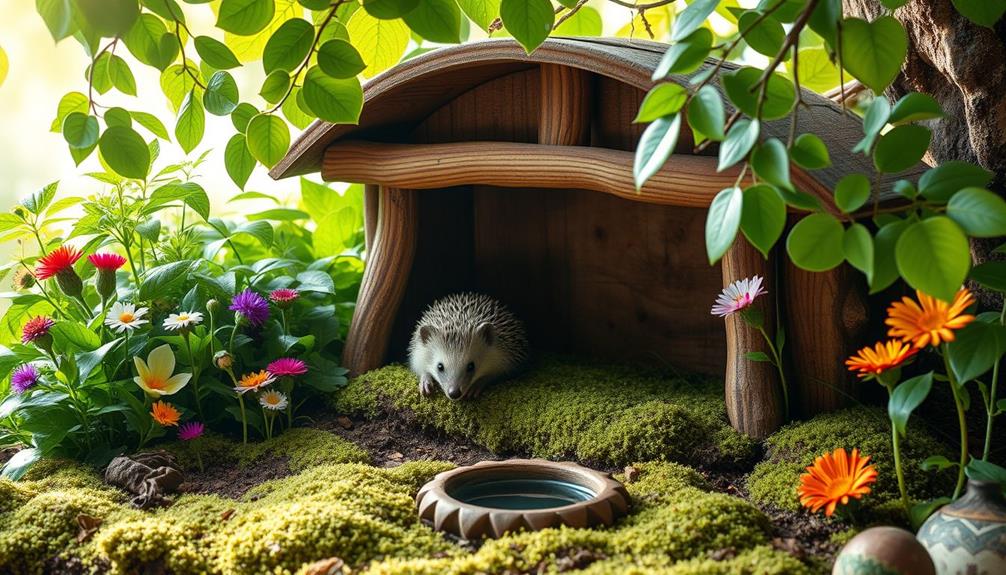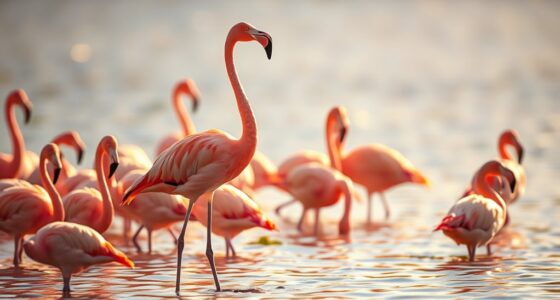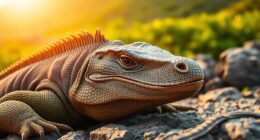Animals protect their young in various ways. They use their bodies to form protective circles, employ camouflage to hide them, and teach survival skills through play. Many mark their territory with scent to deter threats, while others migrate to safer environments. Emotional bonds drive parental investment, with some species engaging in extensive care. As you explore further, you'll uncover fascinating examples of how different animals guarantee the safety and well-being of their offspring.
Key Takeaways
- Animals use physical protection, like elephants forming circles around calves, to deter predators and ensure safety.
- Camouflage techniques, such as speckled fawns and hidden nests, help young animals evade detection from threats.
- Parental teaching involves demonstrating survival skills, like lionesses showing hunting techniques through play or dolphins guiding calves in teamwork.
- Scent marking establishes territory, deterring intruders and creating a safer environment for raising vulnerable young.
- Emotional bonds among species, such as elephants and dolphins, enhance protective behaviors and community involvement in caring for offspring.
Using Their Bodies for Protection

When it comes to protecting their young, many animals instinctively use their bodies as shields. Elephants form protective circles around their vulnerable babies, deterring predators and ensuring safety.
Kangaroo mothers carry their joeys in pouches, allowing for skin-to-skin contact that provides security during their early development.
Panda moms cradle their fragile cubs, born weighing only three to five ounces, offering warmth and protection until they grow stronger.
In cold weather, animals huddle together, using their bodies to stay together and shield their young from the chill.
Female tigers mark their territory with scent, signaling their presence and creating a safe environment for their offspring.
These strategies highlight the lengths animals go to protect their young from threats.
Camouflage Techniques in Nature

Animals employ various strategies to safeguard their young, and one of the most fascinating methods is camouflage. Many animals, like deer and rabbits, have fur that blends seamlessly into their environment, effectively hiding their young from predators.
Birds, such as eagles and ospreys, build nests in hard-to-reach locations, further reducing visibility for their vulnerable eggs and fledglings. The speckled coats of fawns allow them to merge with the forest floor, making them less detectable to lurking threats.
Even the octopus showcases remarkable survival skills by changing its skin color and texture to mimic its surroundings, providing essential protection during sensitive stages.
Camouflage considerably increases the chances of survival for young animals until they're ready to fend for themselves.
Teaching Survival Skills to Offspring

In the wild, animals actively teach their young vital survival skills through hands-on experiences.
From lionesses demonstrating hunting techniques to dolphin mothers sharing foraging strategies, these lessons are imperative for the offspring's independence.
You'll see how each species adapts their teaching methods to guarantee their young thrive in their specific environments.
Hunting Techniques Demonstration
Teaching survival skills to their young is essential for many species, and various animals have developed unique methods to demonstrate hunting techniques. For instance, lionesses engage their cubs in play fights with prey, allowing them to practice safely. Cheetah mothers move their young ones frequently, teaching them to stay hidden while honing their hunting skills. Wolves involve their young in pack hunts, where they learn by observing older members. Dolphins guide their calves through coordinated strategies, enhancing teamwork. Orca mothers use vocalizations and movements to instruct their young on capturing prey effectively.
| Animal | Hunting Technique Demonstration |
|---|---|
| Lionesses | Play with prey for skill practice |
| Cheetahs | Frequent relocation for hiding skills |
| Wolves | Participation in pack hunts |
| Dolphins | Coordinated group strategies |
Foraging and Water Sources
Many species not only demonstrate hunting techniques but also focus on foraging and finding water sources, which are essential for their young's survival.
For instance, orangutan mothers spend significant time with their young, teaching them how to find food and recognize edible plants in their surroundings.
Similarly, cheetah mothers frequently move their cubs to various locations, helping them learn about different foraging grounds while emphasizing the importance of stealth.
Dolphin mothers guide their calves to safe water sources, teaching them how to navigate their environment effectively.
Even polar bear mothers guarantee their cubs develop survival skills by demonstrating how to hunt seals, passing down techniques learned from their own mothers.
All of these actions play a fundamental role in their offspring's future success.
Social Cooperation Activities
While some animals instinctively know how to survive, others rely on social cooperation to learn crucial skills from their parents. Animal mothers exhibit a powerful maternal instinct, nurturing their young through various teaching methods. By working together, they guarantee their offspring thrive in the wild.
- Lionesses play with prey, showcasing hunting techniques.
- Cheetah mothers relocate their cubs, training them over 18 months.
- Orangutan mothers spend six to seven years teaching food sourcing and nest building.
- Dolphin mothers nurse and teach social behaviors for survival.
These activities highlight the profound care for their young, emphasizing the significance of learning in the animal kingdom. Through social cooperation, these mothers equip their young with essential skills for life.
The Role of Scent Marking
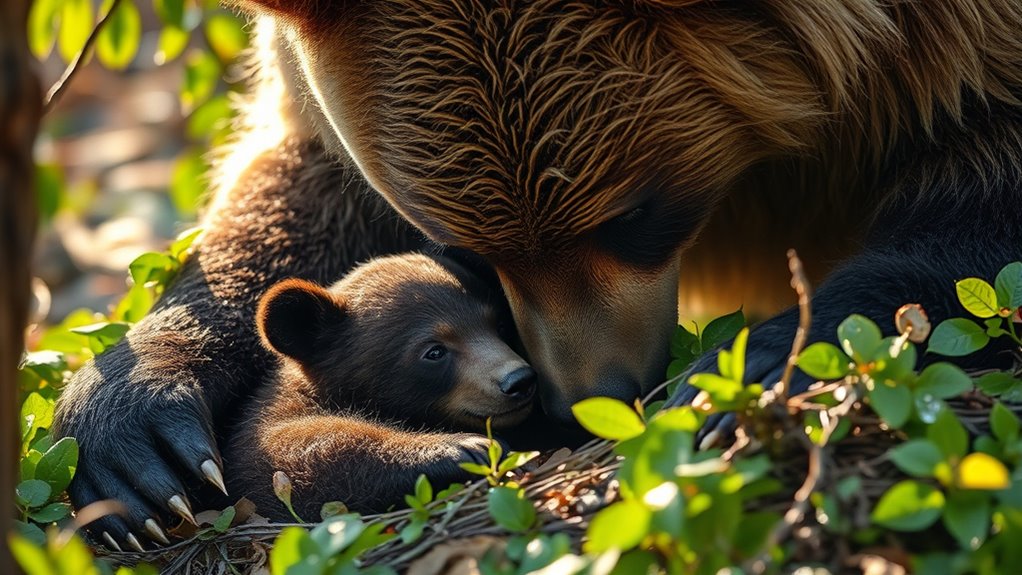
When you think about how animals protect their young, scent marking often plays a vital role.
Territorial Marking Behavior
Territorial marking behavior plays a significant role in how animals protect their young, particularly among big cats like tigers and lions. By using scent marking, these mothers signal their presence and deter potential threats, ensuring their offspring's safety.
This behavior not only establishes a territory but also communicates essential information to others.
- It warns intruders to stay away.
- It reduces the risk of conflict.
- It creates a safe environment for raising young.
- It reinforces family bonds within the pride.
Through maternal protection and strategic territorial marking, these big cats enhance their young's chances of survival, demonstrating the powerful instinctual behaviors that prioritize the well-being of their vulnerable offspring.
Warning Signals to Predators
Scent marking serves as a significant warning signal to predators, ensuring that potential threats recognize the presence of a mother and her young. Female big cats, like tigers and leopards, use urine to establish territorial boundaries and deter intruders. This behavior not only protects their young but also communicates essential information to other animals.
| Animal Type | Scent Marking Purpose | Example Species |
|---|---|---|
| Big Cats | Deter predators | Tigers, Leopards |
| Rodents | Establish territory | Various species |
| Canids | Signal presence of offspring | Wolves, Foxes |
Importance for Offspring Safety
Protecting their young is a top priority for many animal mothers, and scent marking plays an essential role in this endeavor. By marking their territory, mothers create a safe space that helps shield their cubs from potential threats.
Here's how scent marking contributes to the safety of offspring:
- It establishes boundaries, warning rivals to stay away.
- It creates a buffer zone, reducing predator encounters.
- It communicates crucial territory information to other animals.
- It showcases maternal strength, ensuring their young can thrive.
These survival skills allow mothers to effectively protect their offspring, ensuring they grow in a secure environment.
Scent marking is more than just a behavior; it's a lifeline for the cubs, helping mothers stay vigilant and proactive in their care.
Migration and Movement Strategies

Migration and movement strategies play an essential role in ensuring the survival of young animals. Many mothers migrate to find ideal breeding grounds, like Arctic terns and salmon. Polar bear mothers dig snow dens to keep their cubs safe from harsh weather. Elephants move their herds of females to areas with abundant food, critical for nursing. Seasonal migration patterns, like those of wildebeests, help minimize predation risks for their young. Additionally, dolphins herd their calves to the center of the pod during threats, showcasing the significance of mobility.
| Animal | Strategy |
|---|---|
| Arctic Terns | Long-distance migration |
| Polar Bears | Digging dens for shelter |
| Elephants | Moving herds for food |
| Wildebeests | Seasonal migration |
| Dolphins | Herding calves for safety |
Parental Investment Across Species
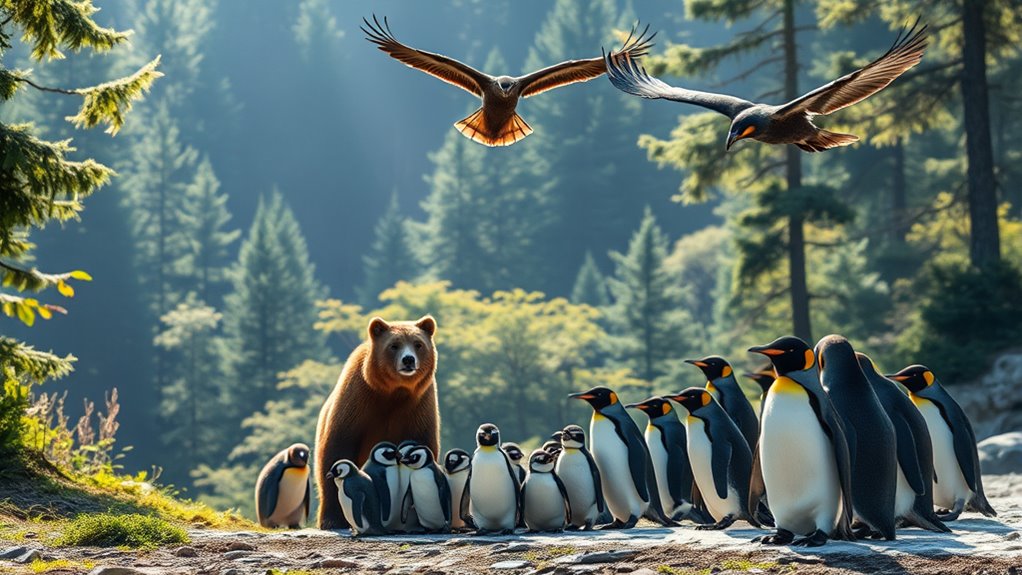
When it comes to raising their young, animals exhibit a fascinating range of parental investment strategies that vary widely across species.
You'll notice that mammals often provide extensive care, while reptiles, birds, and fish might show minimal involvement.
Here are some key aspects of parental investment:
- Direct care like feeding and grooming.
- Indirect care, such as building nests for safety.
- Community involvement in social species, like elephants or bees.
- Varied durations of care based on developmental needs.
These strategies not only enhance the survival skills of the young but also reflect the unique adaptations of each species to their environment.
Understanding these differences deepens your appreciation for the complexities of animal parenting.
Variations in Care by Environment
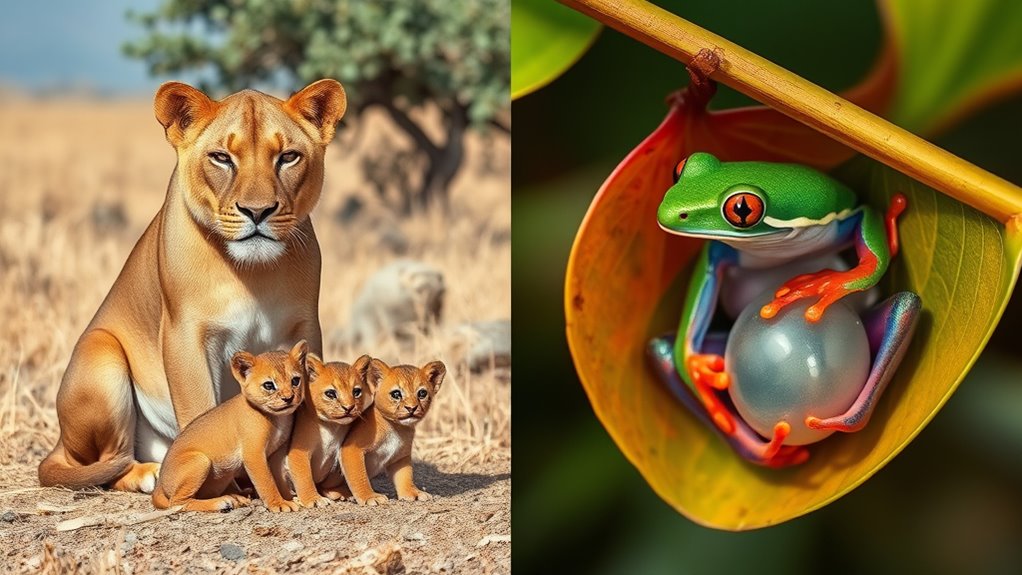
Environmental factors play an essential role in shaping how animals care for their young, influencing everything from nesting sites to protection strategies.
In harsh climates like the Arctic, polar bear mothers dig snow dens to shield their cubs from extreme temperatures and predators, showcasing proactive parental care.
Birds that nest in trees often select hard-to-reach locations to reduce the risk of predation, adapting their nesting strategies to their environments.
In aquatic habitats, species like salmon migrate to find safer breeding grounds with ample resources for their young.
Terrestrial mammals, such as deer and rabbits, have evolved camouflage in their fur to conceal their offspring from predators, demonstrating how physical traits adapt to the need for protection in specific environments.
Emotional Bonds and Maternal Instincts
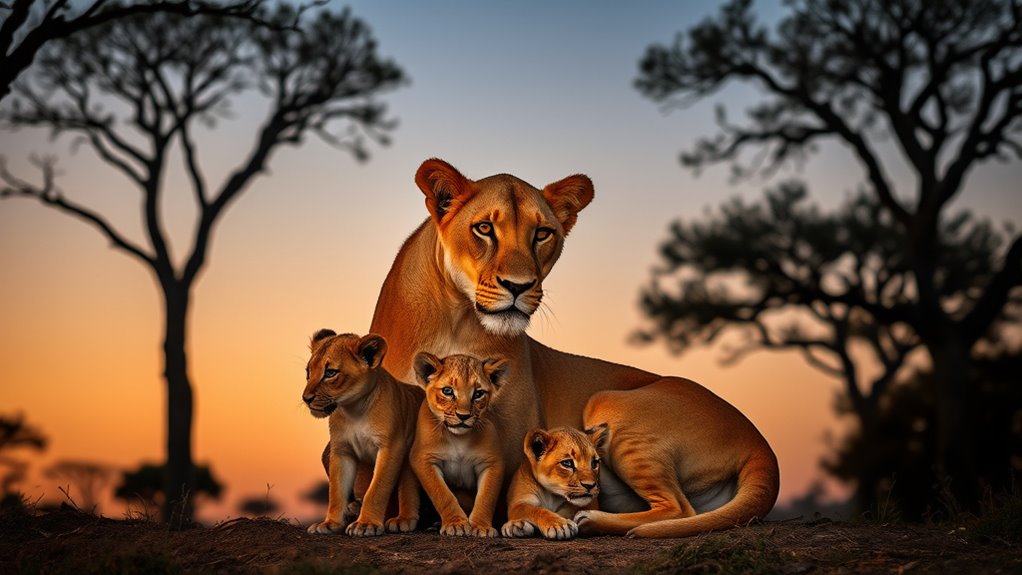
Animal care goes beyond mere survival strategies; emotional bonds play a significant role in how mothers protect and nurture their young. These maternal instincts often manifest in profound ways that highlight the depth of connection between mothers and their offspring.
Emotional bonds are essential in animal care, showcasing the profound connections between mothers and their young.
- Elephants form protective circles around distressed calves, showcasing their empathy.
- Orangutans nurture their young for six to seven years, teaching survival skills and social behaviors.
- Dolphins and chimpanzees exhibit strong social ties, enhancing protective behaviors.
- Many mothers display grief when their young are threatened or lost, illustrating the pain of separation.
These emotional bonds not only strengthen family ties but also guarantee the safety and well-being of the next generation, proving that love is an integral part of animal life.
Examples of Protective Behavior in Animals
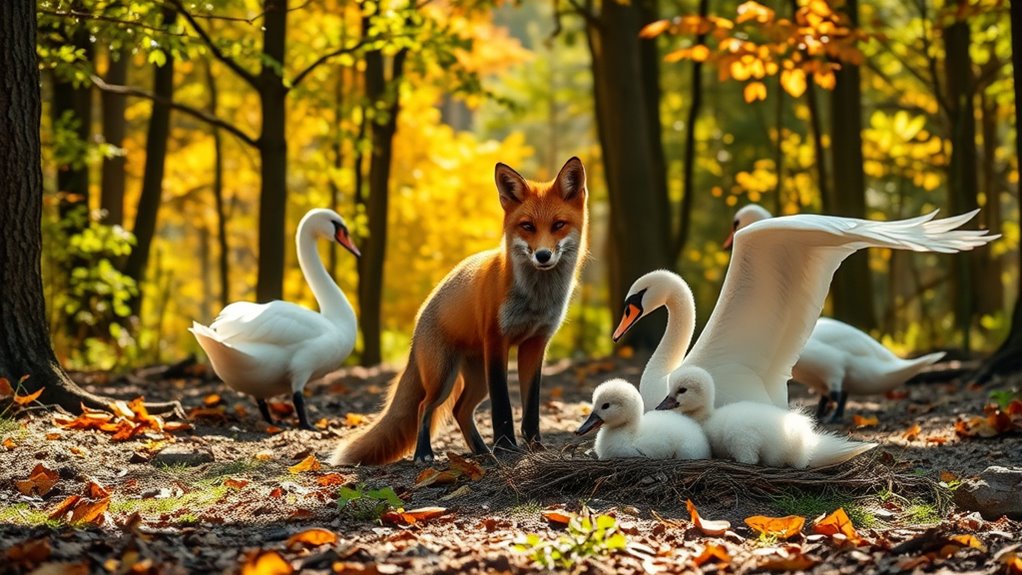
To guarantee their young survive in a world filled with dangers, many species display remarkable protective behaviors.
Elephant herds form protective circles around their calves, using their bodies to shield them from predators during travel.
Kangaroo moms stay close, carrying their vulnerable joeys in pouches for months, ensuring they receive constant protection.
Cheetah mothers isolate their cubs, moving them every few days to avoid detection, while emperor penguin males incubate eggs and shield them from harsh conditions as females search for food.
In the ocean, dolphin pods rely on teamwork, herding young calves to the center during predator attacks, effectively enhancing the safety of their offspring.
These behaviors illustrate the lengths animals go to protect their young.
Frequently Asked Questions
How Does the Animal Care for Its Young?
When you think about how animals care for their young, you'll notice various approaches. Some mothers feed and groom their offspring, teaching them essential survival skills.
Others use physical methods, like carrying their young or forming protective circles. You'll also see animals employing camouflage to hide their babies from predators.
In social species, family members work together to nurture and teach, improving the young ones' chances of survival in their environments.
How Do Animals Take Care of Their Babies?
You'll find that animals take care of their babies in various ways. They often provide warmth and safety, like when a mother kangaroo carries her young in a pouch.
Many teach essential survival skills, showing their offspring how to hunt or find food. Some use camouflage to hide their babies from predators, while others mark their territory to guarantee safety.
How Do Animals Protect Themselves Kids?
Animals protect themselves and their young in various ways. You might see deer and rabbits using camouflage to blend into their surroundings, making it tough for predators to spot them.
Elephants and kangaroos form protective circles, leveraging their size to fend off threats. Meanwhile, social animals like lions and wolves work together, ensuring safety in numbers.
Whether through distraction tactics or collective defense, these strategies showcase their instinctual drive to safeguard against danger.
What Male Animal Protects Its Young?
When you think about male animals protecting their young, consider the male Emperor penguin. They incubate eggs while the females hunt, keeping the eggs warm in freezing temperatures.
Similarly, male lions defend their territory and cubs from threats, ensuring their safety.
Male seahorses take it a step further by carrying the fertilized eggs in their pouch until they hatch.
These examples show how various male animals take active roles in safeguarding their offspring.
Conclusion
In the grand tapestry of life, every parent plays the role of a guardian knight, donning the armor of instinct and wisdom. Just as a tree shelters its saplings from the storm, animals weave their protective strategies, ensuring the next generation thrives. Whether through camouflage or teaching, their unwavering dedication echoes in the wild. So, as you walk through nature's kingdom, remember that every rustle and call carries the heartbeat of a parent, fiercely loving and ever watchful.



